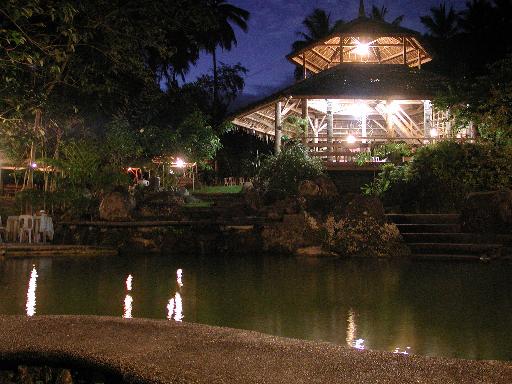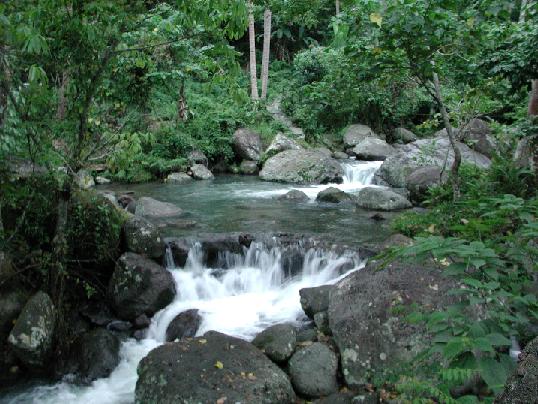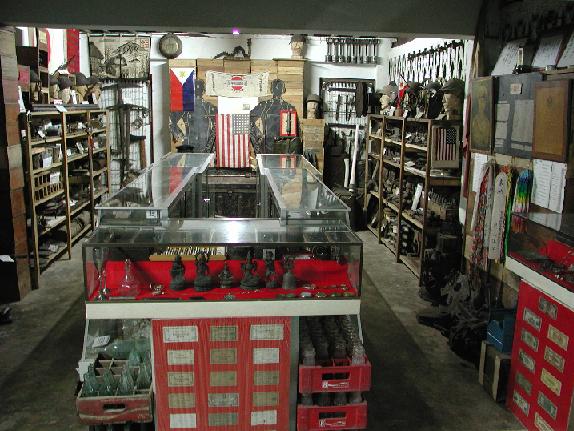Greening in Valencia
Text & Photos By Roel Hoang Manipon
 The name Valencia may sound European, evoking images of quaint rows of stone houses and cobblestone walks. More so if you meet their mayor Rodolfo V. Gonzales, Jr., whose Castilian features remind one of stage director Tony Mabesa or character actor Tony Carreon. But Valencia in Negros Oriental would conjure, if one has visited, images mainly of lush vegetation and mountains. Valencia is considered here a kind of the province’s mountain resort just as Baguio is to Luzon. While Baguio is cooler, Valencia is moderate. But compared to the rest of the province, it is relatively cooler. Baguio is urbanized but Valencia somehow remains, in a way, pristine.
The name Valencia may sound European, evoking images of quaint rows of stone houses and cobblestone walks. More so if you meet their mayor Rodolfo V. Gonzales, Jr., whose Castilian features remind one of stage director Tony Mabesa or character actor Tony Carreon. But Valencia in Negros Oriental would conjure, if one has visited, images mainly of lush vegetation and mountains. Valencia is considered here a kind of the province’s mountain resort just as Baguio is to Luzon. While Baguio is cooler, Valencia is moderate. But compared to the rest of the province, it is relatively cooler. Baguio is urbanized but Valencia somehow remains, in a way, pristine. The town is 9.40 kilometers away or just 30 minutes ride from Dumaguete City, the province’s capital. It is actually near. The land area of 7,716 sq km is a treasury of greenery, beautiful with Mt. Talinis or Cuernos de Negros (Horns of Negros) as backdrop. Sixty-five percent of Valencia is actually mountain terrain and thirty-five percent is rolling plains and the rest is used for agriculture, which is the main livelihood of the people. Though its population is 20,147, the place seems un-crowded and peaceful.
 It was already night when we arrived in Valencia from gallivanting around the province. We were sea-fresh, salt-and-wind-scrubbed and sun-reddened from the visit to Apo Island, whose offers were untamed beaches and striking reefs and fishes. So Valencia proved to be a different world and one realized the wonderful diversity in just a few kilometers.
It was already night when we arrived in Valencia from gallivanting around the province. We were sea-fresh, salt-and-wind-scrubbed and sun-reddened from the visit to Apo Island, whose offers were untamed beaches and striking reefs and fishes. So Valencia proved to be a different world and one realized the wonderful diversity in just a few kilometers. Mayor Gonzales, with his officials, welcomed us in Forest Camp, which is a camping area and resort offering communion with nature. The grass, which virtually carpeted the whole area, was tingly with dew-laden blades. With the backdrop of forest that seemed to hold the darkness of the night and the sound of cicadas, they set up tables around a bonfire where we had dinner until the late night’s mist came. To get the feel of the area with its feel of dampness and its curious little insects, we slept in tents.
I was awakened when the sunlight fell on our tent making it a hothouse, and came out to see the camp in the daylight, a sprawling park-like tract of land. Forest Camp seemed to me the most beautiful campsite resort in the country. The camp has uneven terrain, vibrant with trees and coconuts. There was a creek running through it, feeding two man-made swimming pools. Over it was a hanging bridge. Footpaths inlaid with stones sliced through the tingly grass carpet. There was an area where you can set up tents, a common bathroom and toilet, and areas where you cook and grill. But there is also a restaurant at the center of the site. There were also nice, comfy cottages for those who want to straddle between modern comfort and nature. But the centerpiece remains to be a magnificent tree house. At the end part of the site, the area sloped upwards towards a forest, where you can trek and then further is already mountain.
Breakfast was a great idea. And here one can really savor Negros Oriental’s favorite snack: budbod kabog, a kind of suman made from glutinous rice and coconut milk and wrapped in banana leaves, which is dipped in hot chocolate and eaten with slices of ripe mangoes. Of course, there is the much-talked about danggit and fried rice. One is constantly reminded of nature because a brash and inquisitive blackbird dropped in our breakfast and stole our food. It will also rummage through your things if you left them in the open.
Forest Camp in Apolong, Valencia, is owned by Florante Vicuña and wife Melba. They are really Ilocano, who migrated into Valencia and started the camp with a small piece of land and then expanding it by acquiring adjacent tracts.
After breakfast, we headed to our first destination, which curiously was the PNOC Geothermal Plant in Barrio Puhagan. Plants and factories are not really touristy spots to visit, but the geothermal plant in Valencia is an interesting sights, which owes largely to its picturesque surroundings. It was a bumpy but pleasant ride up the mountains, where the greenery was broken by occasional houses with a garden of curious flowering plants like a small tree-like plat with large, peach-colored, trumpet-shaped flowers hang droopingly from its branches. It was an indication that the area is home to fascinating flora and fauna.
 Before visiting the plant itself, we were brought to a vantage where we could see the plant from above, a real panoramic view. The plant is nestled among the verdant Cuernos de Negros mountain, like a big shiny steel machine spouting steam lying among the vegetation. The PNOC was a result of the 1975 exploration of geothermal resources in the area jointly undertaken by the Philippines and New Zealand. The plant presently supplies power to the whole province and parts of Central Visayas. Plant personnel seemed to be used to having visitors as they were treated to an informative lecture of how volcanic heat is harnessed from the earth, goes to this and that pipes, and is transformed into electricity. And we toured through the facilities to the control room with its multitude of green and red buttons glowing like Christmas lights to the rooftop with its humungous stacks spewing off steam like hyperactive dragons. One might think that such a plant in an environmentally precious area is an incongruity. But it seemed to me that the plant and its environment were complementary. I really like places where human structures and nature harmonize. The plant does not pollute, actually. Its waste product is mainly water from the steam and this water is treated for any high concentration of minerals that may cause imbalance. The PNOC Geothermal Plant is into environmentally concerns. A large part of mountain they declared a reservation under their protection. Aside from preserving Valencia’s environment, the plant could be the town’s biggest employer, helping with the economy of the area.
Before visiting the plant itself, we were brought to a vantage where we could see the plant from above, a real panoramic view. The plant is nestled among the verdant Cuernos de Negros mountain, like a big shiny steel machine spouting steam lying among the vegetation. The PNOC was a result of the 1975 exploration of geothermal resources in the area jointly undertaken by the Philippines and New Zealand. The plant presently supplies power to the whole province and parts of Central Visayas. Plant personnel seemed to be used to having visitors as they were treated to an informative lecture of how volcanic heat is harnessed from the earth, goes to this and that pipes, and is transformed into electricity. And we toured through the facilities to the control room with its multitude of green and red buttons glowing like Christmas lights to the rooftop with its humungous stacks spewing off steam like hyperactive dragons. One might think that such a plant in an environmentally precious area is an incongruity. But it seemed to me that the plant and its environment were complementary. I really like places where human structures and nature harmonize. The plant does not pollute, actually. Its waste product is mainly water from the steam and this water is treated for any high concentration of minerals that may cause imbalance. The PNOC Geothermal Plant is into environmentally concerns. A large part of mountain they declared a reservation under their protection. Aside from preserving Valencia’s environment, the plant could be the town’s biggest employer, helping with the economy of the area. Maybe plants and factories can be included in tours, a sort of scientific travel that can go hand and hand with cultural explorations.
After the scientific, we went cultural. We went to the Cata-al Private Museum of World War II memorabilia. It is recommended that any visit to any place must have for its initial stop a museum. But it seemed that when Filipinos go on a tour, museums are not a primary destination. And Philippines does not have many museums, and if it has, they are not really patronized, prided or cherished. Although, there are some visionary patches the population which strives for them like the private museum Cata-al. An identification of how developed a place or civilization or the caliber of the people is the presence of a good museum, and how well maintained it is, or how valued or cared for the items in its possession. The existence of good museums bespeak of the advancement, culture and intelligence of the people.
Actually the Negros Oriental province has no museum unlike its sister province Negros Occidental which has a competent museum, which however needs improvement. Museums here are not supported by the government like the museums of the Silliman University in Dumaguete and the private Cata-al museum.
The museum was really a private home, with a sign on the front gate in Japanese, a front yard that was variably unkempt and a small creek running beside it. The house was a modest two-story affair. The makeshift garage housed an old army jeep. An identification that told that this was no ordinary house was a few, large rusting bombs station in front of the house.
The collection of was housed in the house’s silong. And it was an impressive collection items from dog tags, metal canteens to uniforms crammed the area. The museum is divided into two parts. The first part is the World War II memorabilia and this was largely items from, and about the Japanese Imperial Army and a smattering of US Armed Forces. Part of the collection are the bones of Japanese soldiers. The bones collection started in Oct. 1986 with 17 sets donated by the Lion’s Club of Japan. And then diggings in the area resulted 7 sets in 2000 and 4 sets in 2001. Most of the bones are donated to Sokoni Shrine in Tokyo and the Emperor’s museum.
The second part is a personal collection, which includes antiques, coins, old bottles, musical instruments like harp and violin, miniature models, replica of military vehicles, etc.
The museum was started by Felix Constantino V. Cata-al who actually studied agriculture. It started as hobby when he was a boy in 1967-1968. The bulk of the present collection came after 1981. Mr. Cata-al personally funded searches like diggings in the area for his collection. Others came from purchases from other people, exchanges and loan for display by private individuals. Diggings were done in the barangay of Sagbang, were many World War II items were found.
Sagbang was actually our next stop, not to dig though from World War II treasures (rumor has it that there have been diggings in connection to the Yamashita treasure) but to visit the Philippine-American-Japanese Amity Shrine. Our way to the shrine was through Dumaguete City. After going through the city we entered a small road and suddenly we were going up the mountains where the ride became increasingly bumpy and sometimes difficult. A slight rain can make the ground very slippery and once we were stuck. The shrine itself may not worth the travel there. It was just a simple affair, a three-sided tower and steps around it and a cordoned off park. A marker was supposed to be in a corner wall but it was stolen as many people visit to camp in the area. What could be worth it was the view. From this point, one could see the nearby island provinces of Siquijor and Cebu.
Sagbang was actually the last stronghold of the Japanese forces in the province. The shrine was erected in 1977 in memory of those who died and also as a symbol of friendship and end of World War II hostilities. We were amiably and hospitably greeted by baranggay officials of Sagbang, which seemed to be of Agta descent. While the mayor sincerely conversed with the woman baranggay captain about local affairs, we were offered a modest snack of boiled saging na saba and kamoteng kahoy, an effort that can be subtly touching.
Before we knew it, our time was up in Valencia, and there were many things to visits like the Casaroro Falls, Pulangbato Falls, Lake Melipendol, Lake Yayumyum and Lake Halawig, which are all in Mt. Talinis or Cuernos de Negros. Now, Mt. Talinis, which reaches the height of 1,938 meters, is a favorite and marvelous mountain to climb for mountain climbers and enthusiasts. As mentioned, the mountain is home to interesting flora and fauna. The rare spotted deer is believe to be found only in this mountain. And then there are the Bleeding heart pigeon, the Visayan warty pig, the Visayan writhed hornbill and the Visayan tarictic hornbill. But seemed that we had to Mt. Talinis to a later, indefinite date. And we were not really geared by a high-impact mountain climbing. So our travel diary was filled with places in the foot of the mountain, but these were good memories enough, so good and so green. Now we will remember Valencia not with cobblestone walks but of mountain trails that leads to adventure.
*Roel Hoang Manipon is a free lance journalist whose articles about Philippine arts have been published in various dailies. He took up MFA Creative Writing at the De La Salle University.
Source: lakbaypilipinas.com

No comments:
Post a Comment